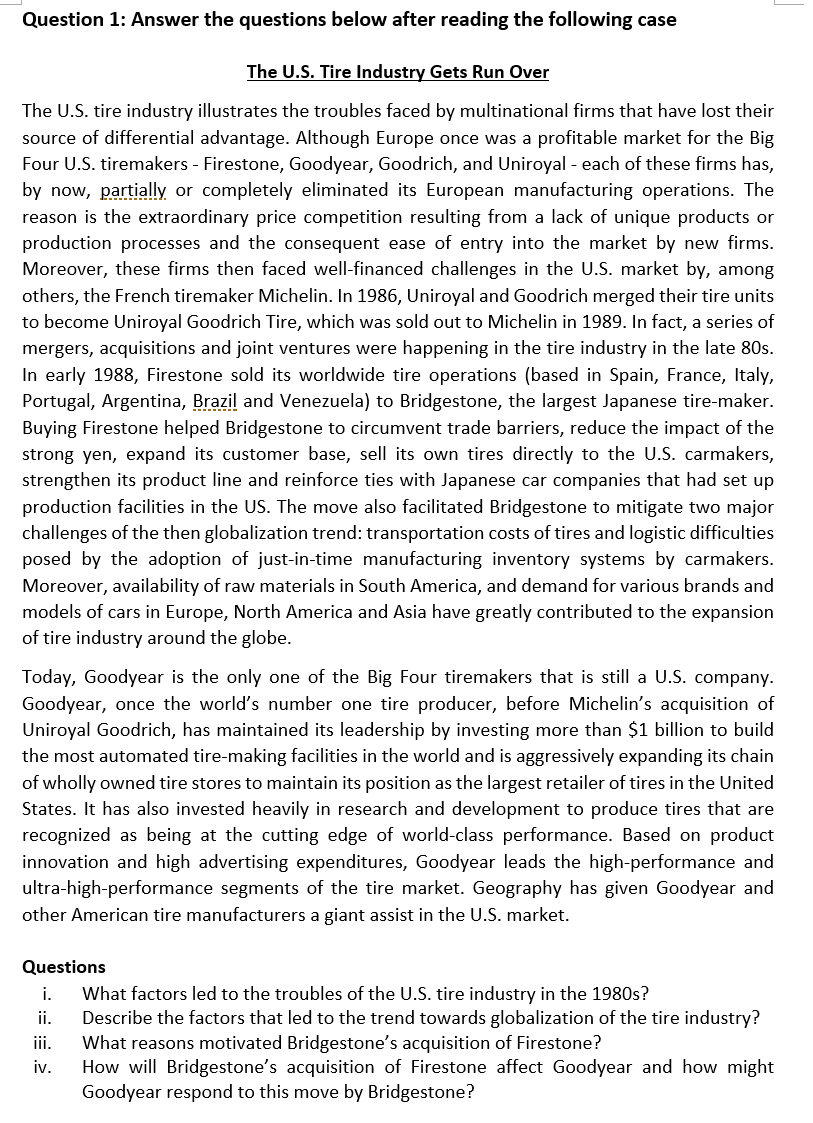
Question 1: Answer the questions below after reading the following case The U.S. Tire Industry Gets Run Over The U.S. tire industry illustrates the troubles faced by multinational firms that have lost their source of differential advantage. Although Europe once was a profitable market for the Big Four U.S. tiremakers - Firestone, Goodyear, Goodrich, and Uniroyal - each of these firms has, by now, partially or completely eliminated its European manufacturing operations. The reason is the extraordinary price competition resulting from a lack of unique products or production processes and the consequent ease of entry into the market by new firms. Moreover, these firms then faced well-financed challenges in the U.S. market by, among others, the French tiremaker Michelin. In 1986, Uniroyal and Goodrich merged their tire units to become Uniroyal Goodrich Tire, which was sold out to Michelin in 1989. In fact, a series of mergers, acquisitions and joint ventures were happening in the tire industry in the late 80s. In early 1988, Firestone sold its worldwide tire operations (based in Spain, France, Italy, Portugal, Argentina, Brazil and Venezuela) to Bridgestone, the largest Japanese tire-maker. Buying Firestone helped Bridgestone to circumvent trade barriers, reduce the impact of the strong yen, expand its customer base, sell its own tires directly to the U.S. carmakers, strengthen its product line and reinforce ties with Japanese car companies that had set up production facilities in the US. The move also facilitated Bridgestone to mitigate two major challenges of the then globalization trend: transportation costs of tires and logistic difficulties posed by the adoption of just-in-time manufacturing inventory systems by carmakers. Moreover, availability of raw materials in South America, and demand for various brands and models of cars in Europe, North America and Asia have greatly contributed to the expansion of tire industry around the globe. Today, Goodyear is the only one of the Big Four tiremakers that is still a U.S. company. Goodyear, once the world's number one tire producer, before Michelin's acquisition of Uniroyal Goodrich, has maintained its leadership by investing more than $1 billion to build the most automated tire-making facilities in the world and is aggressively expanding its chain of wholly owned tire stores to maintain its position as the largest retailer of tires in the United States. It has also invested heavily in research and development to produce tires that are recognized as being at the cutting edge of world-class performance. Based on product innovation and high advertising expenditures, Goodyear leads the high-performance and ultra-high-performance segments of the tire market. Geography has given Goodyear and other American tire manufacturers a giant assist in the U.S. market. Questions i. What factors led to the troubles of the U.S. tire industry in the 1980s? ii. Describe the factors that led to the trend towards globalization of the tire industry? iii. What reasons motivated Bridgestone's acquisition of Firestone? iv. How will Bridgestone's acquisition of Firestone affect Goodyear and how might Goodyear respond to this move by Bridgestone







